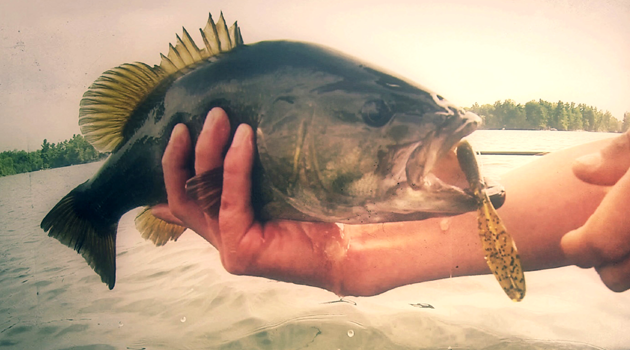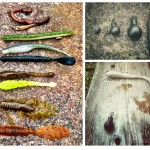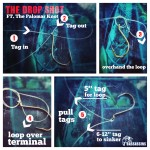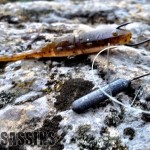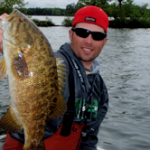By Robert Conley & Robert Fuchs
Long thought of as a finesse technique but often misunderstood, it’s a multi species – go to – super hero. Over the years this simple rig has produced countless fish, often in the trophy range and has established a solid pole position in our arsenal. Tried, tested and succeeded on a multitude of water bodies and a large variety of species, under all kinds of conditions. From shore and boat during fall, winter, spring and throughout summer, it always produces.
With all the glory and mystery surrounding this presentation, lets shed some light on this topic and explore why, when and how to drop shot. The basics are simple, a suspended bait which is held to the bottom by a weight, it’s that easy.
This serves multiple purposes, key players are high visibility of the lure and most important a lower chance for annoying snags. The lure is dancing hypnotically right in front of the predators faces, the obviously easy snack can hardly be resisted by the laziest of beasts. On those dog days when the old lock jaw syndrome rules the waters, the drop still seems to be able to convince the tightest sealed lips.
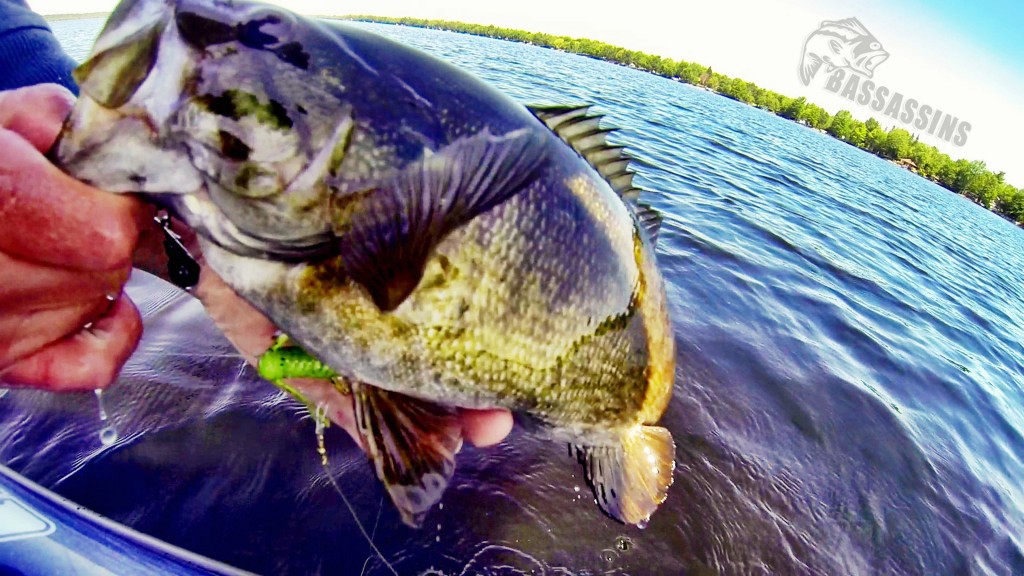
Fish relate to cover and structure so with the lower chance for hang ups, the drop shot can go places where most techniques just can’t, hence the higher rate of success. Rocky or muddy bottoms, boulders, over hang, sunken trees or heavy weeds you name it, the drop likes them all. Of course there are plenty of other techniques that allow you to fish snag free and they are all great. However most have their place and time and none combines it all in to one.
Another major advantage is the low cost of the rig; hooks, weights and some good leader material are next to nothing. They can easily be replaced, fast and on the go. With a little practice a drop shot can be tied within seconds if the need arises. We make it a habit to always have a few prepped over a morning coffee because some days can be worse than others and you might just run out due to some heavy wear and tear.
Not just toothy critters like pike and walleye do damage to the leader, over time bass will take their toll on the tensile strength too. Frequent inspection and replacement will save the embarrassment when a trophy fish gets away at the net because the line was just too compromised when push came to shove.
Its versatility derives from the many kinds of delicious treats this rig delivers for any hungry critter down in the deep. Anything tastes better when it’s dropped, from a worm or minnow to any imaginable soft plastic. Dead or alive, they are all wanted and with this said the choice of what to use is often hard and confusing due to its variety.
In case of doubt, start at the bottom of the food chain. No heads will ever turn away from a tasty worm or a succulent minnow. Crayfish and leeches are also on top of any predators menu, again the idea is to deliver an easy meal that is too good to pass on. Either fresh bait or their fellow soft plastic imitations will catch equally as good. Perhaps if the fish undergo a lot of heavy pressure or are simply just skittish, a natural bait will most likely be more convincing. Our experience has shown that the right presentation of this technique is the ultimate game changer.
Speaking of which, a variety of maneuvers can be executed with the drop. It can be fished horizontally from a boat, through ice, from a peer or a bridge – straight down it goes. It can be trolled or dead sticked but in our books it really shines when its cast. Most important is to keep that steady bottom contact so the lure is always suspended nicely. The line can get some slack every now and then allowing the bait to flutter downwards like an injured fish. Remember the littlest twitch with the tip of the rod lets the bait come alive.
As to speed, the Drop shot generally enjoys a drop and pause than move and pause again presentation. Moving it a few feet after each stop will help to cover more water quickly. Most bites usually occur on the pause and are faint, simply because it is an easy target and doesn’t need much effort. However exceptions make the rule so don’t be surprised if a big northern or bass hammers the shot like it’s a contest.
Jigging the rig is just as effective especially if the fish are biting aggressively during peak feeding times before a storm or simply are really on fire. A little understanding on how fish behave will decide what presentation will be more suitable.
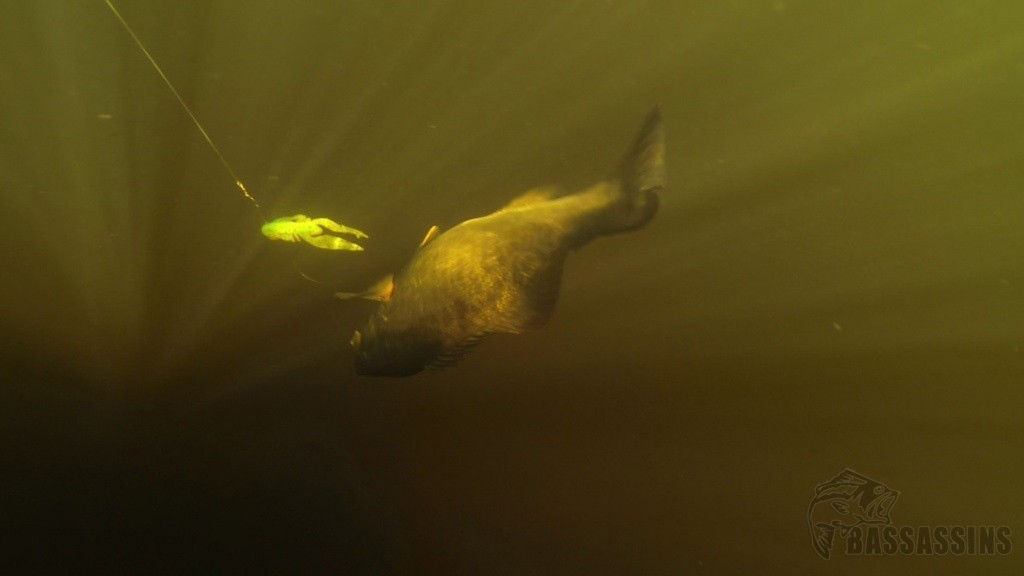
The Build
The epic Palomar knot is the heart of this operation with an added twist, the bottom tag is left on for the weight to be attached. Using a 6-8 lb mono or fluorocarbon leader is recommended due to the lower visibility. In general circle hooks in size 1 are a good bet like the ones shown by Kamakazi. We prefer the “beak” type as the tip bends inwards a little and makes it almost impossible for even the feistiest small mouth to escape during a vicious battle. If bigger craws are used, one can also tie it with an eagle claw style hook.
As for weights, anything goes really, whatever holds it down; adjust weight and size by depth and current. Always try to go as light as possible but still being able to maintain good bottom contact. If an area has a lot of snags from rocks and such we prefer split shots as they tend to slide off easily and can be replaced fast and cheap without losing the whole rig.
We found over the years that drop shoting is a great way to introduce people to fishing because it is so simple and easy to use. Once the basics are understood it seems to come more natural to explore other techniques that are more specific to certain species and conditions. Once you know how to drop shot the wacky rigging, pitching and flipping and so on will be adopted fast as the foundation on how to fish, where to fish and what to fish are already established.
For most of the pros having just one rod in the boat is a big no no and the benefits of multiple rods, each rigged a certain way are tremendous. In real life though, when we take people out fishing, we won’t ask them to bring the whole tackle store. All we need is one rod, one setup and we’ll have a whole lot of fun.
Happy dropping!
Article by The Bassassins, published in Fishing-Headquarters Online Magazine, issue 19 July & August, 2014.
![]()
Robert Conley & Robert Fuchs

Featured Writers & Online Contributors
Our names are Robert Fuchs (Basstard – age 30) and Robert Conley (Smooth – age 31) and we are the Bassassins. We are VERY dedicated and talented anglers combining many different skills to wade the rivers, brave the ice and motor our tinny in and around Ottawa, Ontario. With our GoPro and iPhone always in hand we are on the hunt to bring you the biggest and meanest fish species Ontario has to offer.



